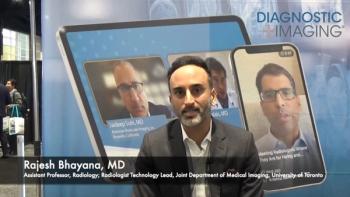
New CT scanner designs break the surface at RSNA
Prototype systems offer a glimpse of tomorrow's CT marketplace
Prototype systems offer a glimpse of tomorrow's CT marketplace
While in the past, vendors focused on increasing the number of rows in a scanner to improve performance, now they are focusing on making new clinical applications possible and developing novel designs, some of which are already available or coming soon to the market. Here are some highlights of new prototypes in the works by vendors.
Vendor: Siemens (Somatom Definition)
Method: Dual source and dual energy
Scanner design: Two x-ray sources mounted onto a single rotating gantry at 90 degrees angles. One detector covers entire scan field-of-view of 50 cm, and the other has a smaller central FOV of 26 cm. Scanning can be performed with one tube or two tubes at different energy levels.
Research sites: New York University; Mayo Clinic; William Beaumont Hospital; Cleveland Clinic; University of California, Los Angeles
Availability: Released commercially in 2005. As of September 2006, 18 scanners were installed worldwide, including eight in the U.S.
Vendor: GE Healthcare
Method: Dual energy
Scanner design: Separate acquisitions are taken at two energy levels on single-tube high-end CT system.
Research site: Kael University, Tokyo
Availability: Pending FDA clearance, scanner with dual-energy capabilities could become commercially available as early as RSNA 2006.
Vendor: Philips
Method: Simultaneous multi-energy detector CT
Scanner design: Detector is composed of layers designed to simultaneously detect low-energy (soft) and high-energy (hard) x-rays. Combining the images from both layers results in a CT image with the full energy of the beam.
Research sites: Hadassah Medical Organization, Jerusalem
Availability: In research stages, clinical experience with 300 cases to be presented at RSNA 2006, pending acceptance as scientific paper.
Vendor: Toshiba
Method: Wide area detector CT
Scanner design: 256-row scanner enables large organ perfusion studies in a single rotation.
Research sites: Fujita Health University School of Medicine, Tokyo
Availability: Could reach the market in two to three years.
Vendor: Prototype uses components of x-ray system from NovaRay of Los Gatos, CA. Research supported in part by GE.
Method: Inverse geometry CT (IGCT)
Scanner design: Many sources separated from each other and a much smaller detector array.
Research site: Stanford University
Availability: In research stages, time to market estimated at five to 10 years.
Newsletter
Stay at the forefront of radiology with the Diagnostic Imaging newsletter, delivering the latest news, clinical insights, and imaging advancements for today’s radiologists.




























